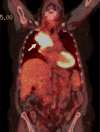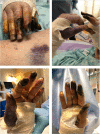Acral vascular necrosis associated with immune-check point inhibitors: case report with literature review
- PMID: 31088420
- PMCID: PMC6518656
- DOI: 10.1186/s12885-019-5661-x
Acral vascular necrosis associated with immune-check point inhibitors: case report with literature review
Abstract
Background: Treatment of solid malignancies has been revolutionized with the introduction of immune checkpoint inhibitors (ICIs) and their use is being expanded in therapy of different cancers. However, immune related adverse events (IRAEs) can occur during treatment. These side effects occur due to stimulation of the innate and adaptive immune system and can lead to serious complications. Recently, acral ischemia has been reported in some cases during treatment with programmed death-1 (PD-1) and cytotoxic T lymphocyte associated antigen-4 (CTLA-4) inhibitors. Here, we discuss a case in which acral necrosis developed after initiation of a PD-1 inhibitor. We offer a review of the existing literature on the pathophysiology, clinical course and treatment outcomes.
Case presentation: A 68-year-old female was diagnosed with stage IV non-small cell lung adenocarcinoma and was started on pembrolizumab. The patient developed sudden onset numbness and discoloration of fingertips bilaterally at week 25 after initiation of ICI treatment. Extensive workup to rule out hypercoagulable, autoimmune and vascular disease was unremarkable except for mild elevation of ANA and ESR. The symptoms quickly progressed into dry gangrene within four weeks and did not respond to medical or surgical treatment. Pembrolizumab was subsequently discontinued due to progression of metastatic disease. The patient refused further interventions and transitioned to hospice care where she expired after two months.
Conclusion: Acral ischemia can develop during treatment of malignancies. This complication, although uncommon, canresult in digital amputation. Physicians should be aware of the possible progression of acral vascular necrosis when Raynaud's like symptoms develop. Larger studies are needed to confirm the role of ICIs in the pathogenesis of acral vascular necrosis.
Keywords: Acral ischemia; Case reports; Immune related adverse events (IRAEs); Immunotherapy; Necrosis; Small vessel vasculitis.
Conflict of interest statement
Ethics approval and consent to participate
Not applicable.
Consent for publication
Written informed consent for publication of the clinical details and clinical images was obtained from the patient’s medical power of attorney. A copy of the written consent is available for review by the editor of the journal.
Competing interests
The authors declare that they have no competing interests.
Publisher’s Note
Springer Nature remains neutral with regard to jurisdictional claims in published maps and institutional affiliations.
Figures


References
Publication types
MeSH terms
Substances
LinkOut - more resources
Full Text Sources
Miscellaneous

